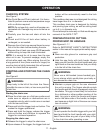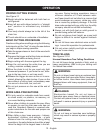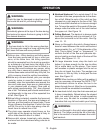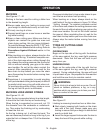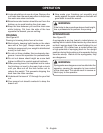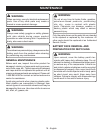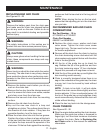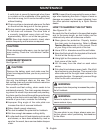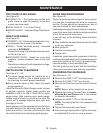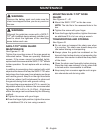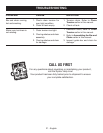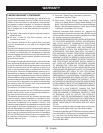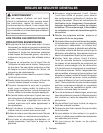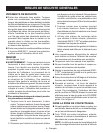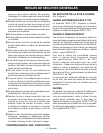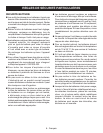
19 - English
TOP PLATE FILING ANGLE
See Figure 35.
CORRECT 30° - File holders are marked with
guide marks to align file properly to produce
correct top plate angle.
LESS THAN 30° - For Cross Cutting.
MORE THAN 30° - Feathered Edge Dulls Quick-
ly.
SIDE PLATE ANGLE
See Figure 36.
CORRECT - 80°
Produced automatically if cor-
rect diameter file is used in file holder.
HOOK - “Grabs” and dulls quickly. Increases
potential of KICKBACK.
Results from using a file with diameter too small,
or file held too low.
BACKWARD SLOPE - Needs too much feed
pressure, causes excessive wear to bar and
chain.
Results from using a file with diameter too large,
or file held too high.
DEPTH GAUGE CLEARANCE
See Figure 37 - 39.
The depth gauge should be maintained at a
clearance of .025 in. Use a depth gauge tool
for checking the depth gauge clearances.
Every time the chain is filed, check the depth
gauge clearance.
Use a Flat File and a Depth Gauge Jointer to lower
all gauges uniformly. Depth gauge jointers are
available in .020 in. to .035 in. Use a .025 in. depth
gauge jointer. After lowering each depth gauge,
restore original shape by rounding the front. Be
careful not to damage adjoining drive links with
the edge of the file.
Depth gauges must be adjusted with the flat file in
the same direction the adjoining cutter was filed
with the round file. Use care not to contact cutter
face with flat file when adjusting depth gauges.
MAINTENANCE
GUIDE BAR MAINTENANCE
See Figure 40.
When the guide bar shows signs of wear, reverse
it on the saw to distribute the wear for maximum
bar life. The bar should be cleaned every day of
use and checked for wear and damage.
Feathering or burring of the bar rails is a normal pro-
cess of bar wear. Such faults should be smoothed
with a file as soon as they occur.
A bar with any of the following faults should be
replaced.
Wear inside the bar rails which permits the chain
to lay over sideways.
Bent guide bar.
Cracked or broken rails.
Spread rails.
In addition, guide bars with a sprocket at their tip
must be lubricated weekly with a grease syringe to
extend the guide bar life. Using a grease syringe,
lubricate weekly in the lubricating hole.
Turn the guide bar and check that the lubrication
holes and chain groove are free from impurities.
REVERSING THE GUIDE BAR
See Figures 41 - 42.
Remove the SAFE-T-TIP
®
mounting screw.
Remove the SAFE-T-TIP
®
from the bar.
Remove the chain from the bar and turn the bar
over.
NOTE: Bottom of bar should not be on top.
Replace the chain on the bar. Refer to Assem-
bling the Bar and Chain earlier in this manual
for specific information.
Replace the SAFE-T-TIP
®
on the bar nose.
NOTE: The locking tab fits in the recessed hole
in the bar.
Tighten the screw with your finger.
From the finger-tight position, tighten the screw
an additional 3/4 of a turn using a wrench.



